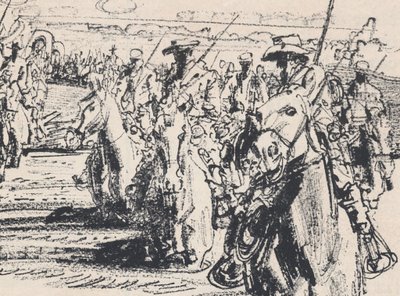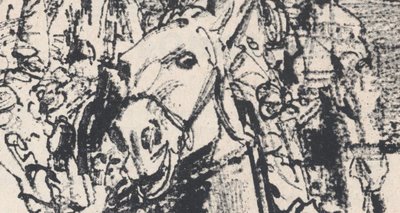
This lovely little drawing by Robert Fawcett appeared in Look Magazine in the 1960s. It was just a spot illustration, about 2 inches across. It is not likely to be reproduced ever again.
In the 1960s, illustration went wild. Innovators used psychedelic colors and bold new styles to create increasingly abstract work. Representational art was declared obsolete. Fawcett, who was trained in a rigorous traditional style, remained unperturbed. In fact, he was amused by the "misconception that abstract qualities are new to contemporary painting, whereas they have been the comparison of excellence since painting began."

Today, all those daring 1960s illustrations with the LSD-inspired paisley designs seem quaint and dated. But if you revisit this tiny little drawing by Fawcett, you will see art that is wild in a more lasting, meaningful sense.

Fawcett often drew conventional subjects using conventional media. He was known for scenes of cultured people in English libraries. But don't be fooled by his subject matter-- he drew them with a powerful, vigorous line. This little drawing is like a DNA sample of the pagan force in Fawcett's drawing. It remains far more wild and frightening today than much of the work that "revolutionaries" such as Peter Max or Bob Peak were producing with the "new freedom" of that era.

5 comments:
What a beautiful piece, and I love how you draw us into the detailed view of the artwork, until it becomes apparent to the viewer how primal the energy of the piece is!
You show us that its possible to appreciate representational art on an abstract level - Do you think the reverse is also true?
Many people who love representational art dismiss anything abstract with a, "My 4 year old kid could have painted that!" comment.
Is that fair? Doesn't it take as much skill to create a powerful abstract work that will move the viewer?
Personally, I have a hard time relating to most abstract art, but I try to keep an open mind. I'm curious to hear how you (and others) feel about it.
Thanks for another great post, David! :-)
I must admit that though I went to art school and did study some history of 20th century art, including non-representational styles (realism and representational art were often looked down upon by many students and teachers), I never quite got it. And even though I love works that are able to communicate objects or places with extreme abstraction or sylization, I am simply more drawn to work that suggests something tangible.
I guess when it comes down to it, aside from a few artists like Pollock, I find pure abstract art to be closer to an exercise in design, which cannot communicate or stand on its own as well as a representational piece can.
I agree with Spacejack..I find a lot of "abstract" art to be conceptual or design exercises. For me they don't get the juices flowing the way a representational piece does.
It's great to see ephemera like this in the spotlight. The items I feature dovetail nicely with this post. Just wanted to say I enjoy your blog.
I know this is a two year old thread, but perhaps the anonymity of that comforts me. I'm rather embarrassed anyway by the stridency of my remarks upon re-encountering them.
I don't know whether my love for abstract art or for representational art came first. I am not fond of Pollock except conceptually, it has little of the beautiful for me, but Kline, wow, and Fawcett's little gem here is awe-inspiring.
Leif queried can we,
"Appreciate abstract art on the representational level?"
I know your not asking me but....yeah I think that is the practice of seeing faces in abstract shapes. I love that border between a mark and it actually representing something. For me that is the most primal act of creativity, image-making. A great artist then is engaged with every aspect of their creation, the beauty of their shapes and marks as well as the beauty of their meanings, which by their combination may come to appear a "realistic" image. The Fawcett drawing is exemplifying this, no?
For me abstract art is a more simple portal to beauty. Representational art however that also has beauty in its constituent elements can take your breath away with it's one-two punch. Could be the abstract or representational that strikes first or maybe both at the same time.
Post a Comment